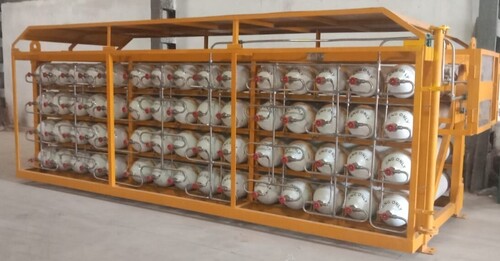CNG Cascade
Product Details:
- Material MS
- Machine Type Semi-Automatic
- Processing Type Gas Handling & Processing
- Equipment Type Gas Cascade System
- Application Gas Compression & Cooling
- Function Compressing and cascading gas for industrial use
- Usage Industrial
- Click to View more
CNG Cascade Price And Quantity
- 200000 INR/Number
- 1 Number
CNG Cascade Product Specifications
- Gas Cascade System
- Gas Handling & Processing
- Compressing and cascading gas for industrial use
- Gas Compression & Cooling
- Industrial
- Semi-Automatic
- MS
CNG Cascade Trade Information
- Ex Works Faridabad
- 30 Number Per Month
- 6 Week
- Yes
- Sample costs shipping and taxes has to be paid by the buyer
- All India
- 1. PESO for Cylinders 2. ISO for Manufacturing Unit
Product Description
Key Components of a CNG Cascade Specification:Cylinder Type and Quantity:
Specifies the type of CNG cylinders used (e.g., Type I, Type IV) and the number of cylinders in the cascade. For example, a cascade might consist of 40 cylinders, each with a 75-liter water capacity.
Water Capacity:
The total water capacity of the cascade, often expressed in liters (e.g., 3000 WL, 4500 WL), indicates the amount of CNG the cascade can hold.
Working Pressure:
The pressure at which the CNG is stored and used, typically 250 bar for many applications.
Test Pressure:
The pressure to which the cascade is tested to ensure its integrity, usually higher than the working pressure (e.g., 400 bar).
Material and Construction:
Details about the materials used for cylinders, piping, valves, and the supporting frame. Often includes specifications for stainless steel (e.g., SS316L) and other materials.
Safety Features:
Includes specifications for pressure relief valves, pressure gauges, temperature gauges, and bleed valves to ensure safe operation.
Mounting and Configuration:
Specifies how the cascade is mounted (e.g., on a truck, as a stationary unit) and the configuration of the cylinders (e.g., single bank, multiple banks).
Performance Standards:
Includes compliance with relevant standards like IS: 7825 (Part 2):2017, Gas Cylinder rules 2016, and PNGRB guidelines.
Corrosion Protection:
Specifies the type of paint and treatment to protect the cascade from corrosion, including fade-free life and resistance to UV damage.
Accessibility:
Details about access to filling and decanting ports, as well as access to cylinder valves.
Testing and Certification:
Includes requirements for cylinder testing and certification, often by a regulatory body like PESO (Petroleum and Explosives Safety Organisation).

Price:
- 50
- 100
- 200
- 250
- 500
- 1000+

 Send Email
Send Email 



